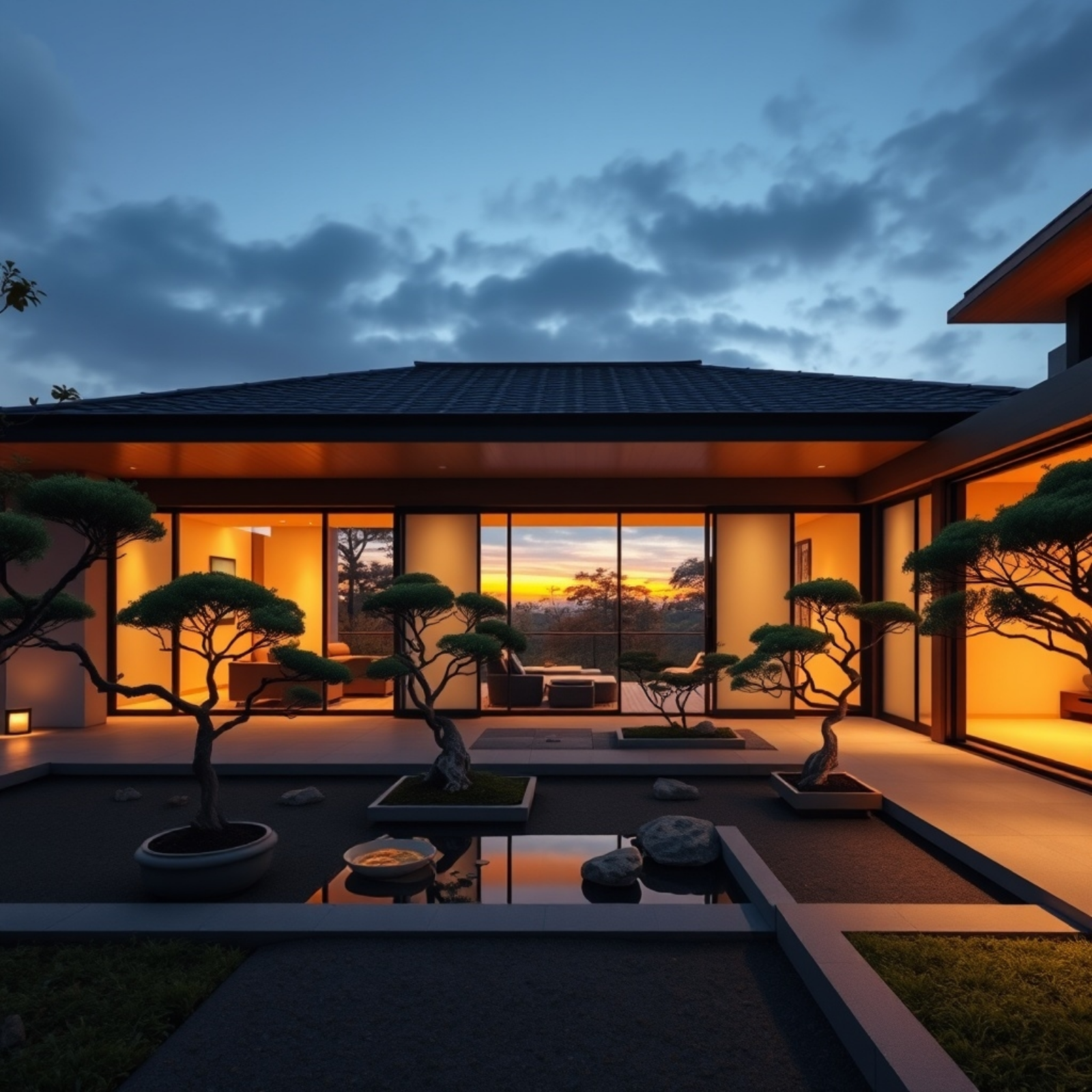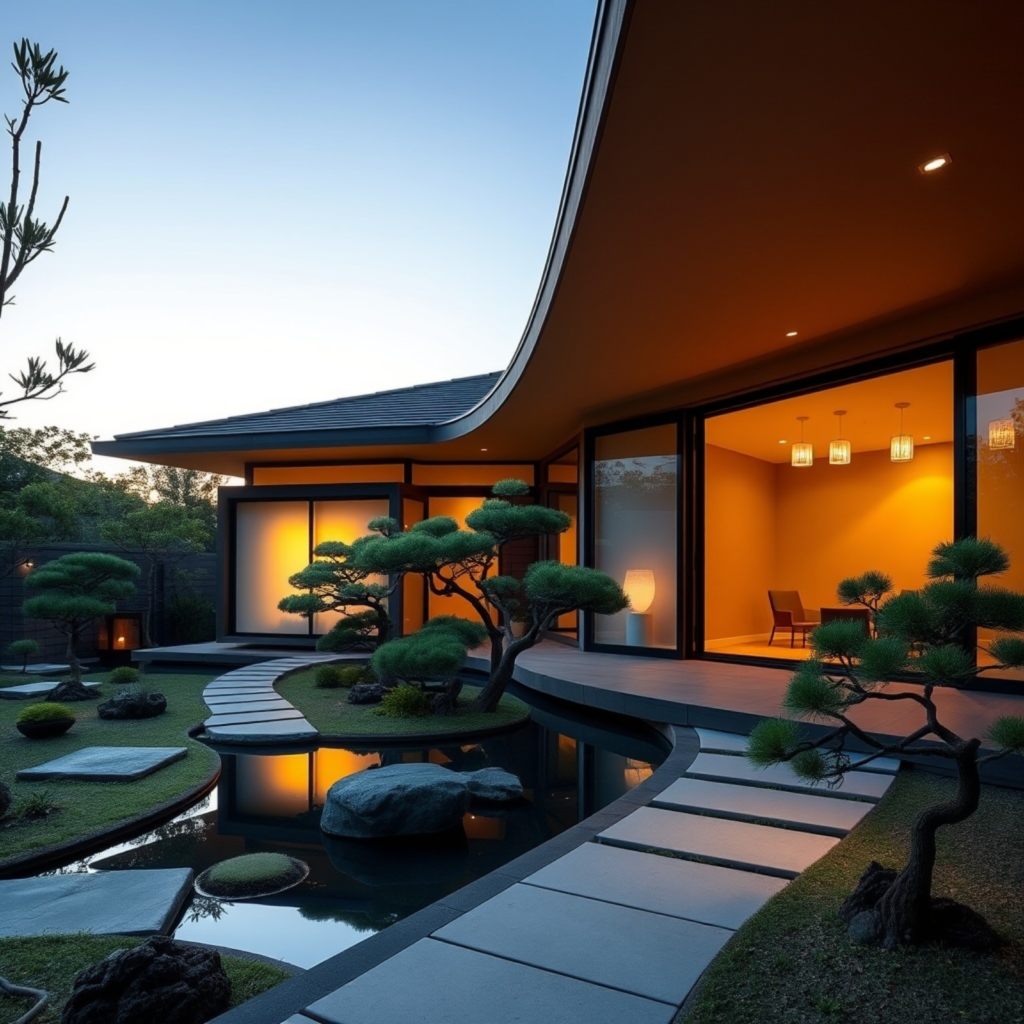

Creating a Zen-inspired home is about more than just aesthetic appeal—it’s about embracing a design philosophy that balances simplicity, nature, and serenity. The images showcased here perfectly illustrate how to combine minimalist architecture with natural elements to craft an environment that fosters peace and harmony. Whether you’re an architect, interior designer, or a homeowner looking to transform your space, this guide will provide valuable insights and tips to help you master this unique style.
Section 1: Defining Zen-Inspired Design
Zen-inspired design draws heavily from traditional Japanese architecture, emphasizing simplicity, clean lines, and a deep connection with nature. The spaces in the images exhibit a sophisticated blend of modernity and tranquility, where architectural form seamlessly integrates with natural elements such as water, trees, and open courtyards.
Architectural Elements:
Each image features an open, airy layout with large glass windows, allowing for a seamless flow between indoor and outdoor spaces. The low-profile, horizontal planes, and sharp angles highlight the minimalist approach to form and function. The careful placement of bonsai trees and stone pathways enhances the sense of calm and order.
Materials and Colors:
Zen-inspired spaces often use natural materials such as wood, stone, and glass. Neutral color palettes, as seen in the images, create a soothing backdrop, while warm lighting adds a touch of intimacy and comfort. Opt for muted tones like beige, soft grey, and earthy browns to maintain balance and tranquility in your space.

Section 2: Interior Design Tips for a Zen-Inspired Home
If you want to replicate this serene style in your home, consider the following tips:
1. Use Minimal Furniture:
Keep furniture choices simple and functional. Low-profile seating arrangements, like those shown in the images, promote a sense of openness and relaxation.
2. Incorporate Natural Elements:
Introduce elements like bonsai trees, small water features, and stone arrangements to bring the outdoors inside. These additions create focal points and help establish a deeper connection with nature.
3. Focus on Lighting:
Lighting plays a crucial role in setting the mood. Soft, warm lighting enhances the natural textures and highlights the clean lines of your interior design. Consider using recessed lighting, floor lamps, or lantern-style fixtures for a balanced ambiance.
4. Create Flow and Harmony:
Use open-plan layouts to connect different areas of your home. Sliding glass doors or partitions can maintain privacy while allowing for flexibility in space management. The flow from one room to another should feel natural and unobstructed.

Section 3: Architectural Insights for Zen-Inspired Exteriors
The exteriors in these images reveal a deep appreciation for balance and proportion. The courtyards serve as sanctuaries, blurring the line between indoor comfort and outdoor tranquility.
Designing a Zen Courtyard:
The courtyards in the images feature carefully manicured bonsai trees, minimalist stone pathways, and reflective water features. To recreate this in your home, prioritize symmetry and use natural materials to create a meditative space that invites relaxation.
Connecting with the Landscape:
Large glass walls frame the view of the surrounding gardens, allowing natural light to fill the space and visually connect the interior with the exterior. This integration is essential for maintaining a sense of openness and unity with the environment.

Section 4: Décor Tips for a Zen-Inspired Space
Less is More:
Embrace minimalism by keeping décor to a minimum. Choose high-quality pieces that serve a purpose and avoid unnecessary clutter.
Use Water Features:
Incorporate small water features, like koi ponds or stone fountains, to introduce a calming auditory element. Water symbolizes renewal and tranquility, making it a perfect addition to a Zen-inspired space.
Organic Shapes and Patterns:
Add visual interest through organic shapes and patterns. The use of rounded stones, curved walkways, and asymmetrical arrangements, as seen in the images, breaks the rigidity of linear architecture and creates a harmonious environment.
Conclusion:
Mastering Zen-inspired design is about embracing simplicity, balance, and a connection with nature. By incorporating these elements into your architectural and interior design, you can create a sanctuary that exudes peace and harmony. Whether you’re redesigning your entire home or just a single room, remember to prioritize open space, natural materials, and thoughtful placement of décor to achieve a tranquil, Zen-like atmosphere.
More Latest Post:
- Islamic Futuristic Architecture: Blending Tradition with Modernity for Sustainable Cities
- Futuristic Architecture and Eco-City Innovations: Design Ideas and Tips for Architects
- Elevate Your Space with Modern Egg Chair Designs
- Modern Homes and Interior Design Tips: A Guide for Homeowners and Designers
- Modern Home Architecture: Design Tips for Builders, Architects, and Investors
